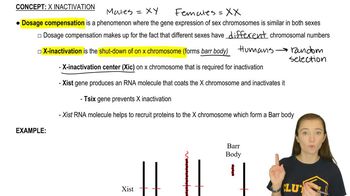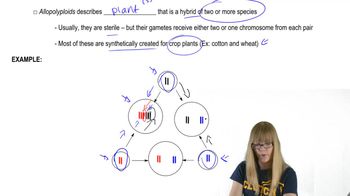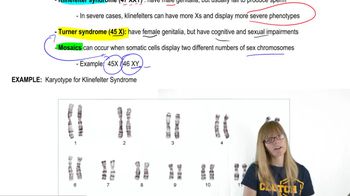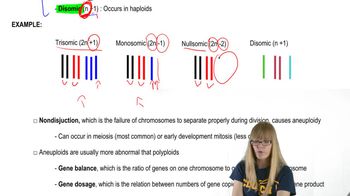Table of contents
- 1. Introduction to Genetics51m
- 2. Mendel's Laws of Inheritance3h 37m
- 3. Extensions to Mendelian Inheritance2h 41m
- 4. Genetic Mapping and Linkage2h 28m
- 5. Genetics of Bacteria and Viruses1h 21m
- 6. Chromosomal Variation1h 48m
- 7. DNA and Chromosome Structure56m
- 8. DNA Replication1h 10m
- 9. Mitosis and Meiosis1h 34m
- 10. Transcription1h 0m
- 11. Translation58m
- 12. Gene Regulation in Prokaryotes1h 19m
- 13. Gene Regulation in Eukaryotes44m
- 14. Genetic Control of Development44m
- 15. Genomes and Genomics1h 50m
- 16. Transposable Elements47m
- 17. Mutation, Repair, and Recombination1h 6m
- 18. Molecular Genetic Tools19m
- 19. Cancer Genetics29m
- 20. Quantitative Genetics1h 26m
- 21. Population Genetics50m
- 22. Evolutionary Genetics29m
6. Chromosomal Variation
Chromosomal Mutations: Aneuploidy
Problem 31b
Textbook Question
For the following crosses, determine as accurately as possible the genotypes of each parent, the parent in whom nondisjunction occurs, and whether nondisjunction takes place in the first or second meiotic division. Both color blindness and hemophilia, a blood-clotting disorder, are X-linked recessive traits. In each case, assume the parents have normal karyotypes (see Table 10.2).
A color-blind man and a woman who is wild type have a daughter with Turner syndrome (XO) who has normal color vision and blood clotting.
 Verified step by step guidance
Verified step by step guidance1
Identify the genotypes of the parents: The color-blind man has the genotype X^cY, where X^c represents the X chromosome with the color blindness allele. The woman, being wild type, has the genotype XX, with both X chromosomes carrying normal alleles for color vision and blood clotting.
Determine the possible gametes from each parent: The man can produce gametes X^c and Y, while the woman can produce gametes X and X.
Consider the daughter's genotype: The daughter with Turner syndrome (XO) has only one X chromosome, which must have come from the mother since she has normal color vision and blood clotting.
Identify the nondisjunction event: Since the daughter has only one X chromosome, nondisjunction must have occurred in the father, resulting in a sperm cell with no sex chromosome.
Determine the stage of nondisjunction: Since the daughter has a normal X chromosome from the mother, the nondisjunction likely occurred during the second meiotic division in the father, where the X^c chromosome failed to separate, resulting in a gamete with no sex chromosome.
Recommended similar problem, with video answer:
 Verified Solution
Verified SolutionThis video solution was recommended by our tutors as helpful for the problem above
Video duration:
1mPlay a video:
Was this helpful?
Key Concepts
Here are the essential concepts you must grasp in order to answer the question correctly.
X-linked Inheritance
X-linked inheritance refers to the pattern of inheritance for genes located on the X chromosome. In this case, color blindness and hemophilia are X-linked recessive traits, meaning that males (XY) are more likely to express these traits since they have only one X chromosome. Females (XX) can be carriers if they have one affected X chromosome but typically do not express the trait unless both X chromosomes are affected.
Recommended video:
Guided course

X-Inactivation
Nondisjunction
Nondisjunction is the failure of homologous chromosomes or sister chromatids to separate properly during cell division, leading to gametes with an abnormal number of chromosomes. This can occur during either the first or second meiotic division. In the context of Turner syndrome (XO), nondisjunction likely occurred during the formation of the egg or sperm, resulting in a missing X chromosome in the daughter.
Recommended video:
Guided course

Allopolyploidy
Turner Syndrome
Turner syndrome is a chromosomal disorder characterized by the presence of a single X chromosome (XO) in females, leading to various developmental and physical features. Individuals with Turner syndrome often have normal color vision and blood clotting if they inherit a normal X chromosome from one parent. Understanding this condition is crucial for analyzing the genetic implications of the cross described in the question.
Recommended video:
Guided course

Human Sex Chromosomes
Related Videos
Related Practice




